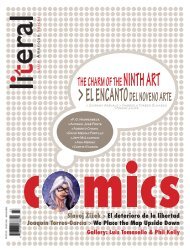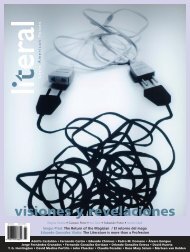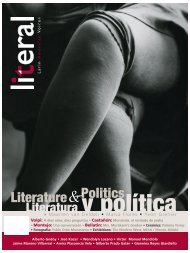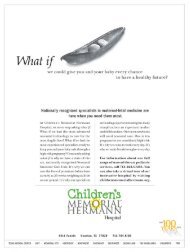Richard Serra - Literal
Richard Serra - Literal
Richard Serra - Literal
Create successful ePaper yourself
Turn your PDF publications into a flip-book with our unique Google optimized e-Paper software.
For thirty-odd years I dedicated myself to collecting and one night, I found myself at dinner with these<br />
two guys. I told them what I was gathering and they offered to help me and I thought, well, maybe they<br />
really mean it, right? One was the city mayor, Andrés Manuel López Obrador,<br />
and the other a businessman, Carlos Slim.<br />
para el museo era una mezcla de alta cultura y cultura<br />
popular, no para contraponerlas, sino para mostrar<br />
cómo van integradas dentro de un gusto popular, pues<br />
el aprecio a lo que a uno lo rodea es lo que descubre<br />
su calidad artística.<br />
r<br />
24 4 L ITERAL. LATIN AMERICAN VOICES • FALL, 2007<br />
Carlos Slim. Both of them came to an agreement, and<br />
they helped me with the museum project. López Obrador<br />
gave us a magnifi cent site, a neoclassical building,<br />
and Slim gave us the profi ts from a record store he<br />
owns to help us pay the salaries of museum employees.<br />
That was our starting point. This alternative curatorial<br />
concept really works, as demonstrated by the fact that<br />
“El Estanquillo” was inaugurated four months ago and<br />
already 65,000 people have visited it, which is quite a<br />
lot for Mexico City. And “El Estanquillo” isn’t the only<br />
museum in this regard, there’s a museum of Economic<br />
History that is doing extraordinarily well; there’s a place<br />
called Indianilla Station for new, postmodern art that<br />
is also working optimally, which demonstrates that<br />
there’s a public for this sort of less traditional museum.<br />
However, the museum par excellence in Mexico City<br />
continues to be the Museum of Anthropology because<br />
it founded an idea, slanted if you will, on a historic<br />
trend of tradition and national patrimony. The next<br />
museum in order of importance is Frida Kahlo’s, due<br />
to any explanation you prefer: she’s a great painter, a<br />
woman who suffered, of feminist attitudes. The third<br />
in terms of visitors is the National Museum of Art, and<br />
then comes us, which is really saying something. The<br />
fact is that between the Museum of Anthropology, the<br />
Frida Kahlo, the National and the other museums in<br />
Mexico City there’s a historic gap; but what the example<br />
of “El Estanquillo” shows us is that there’s also<br />
room for places that young people visit. The recreation<br />
of Mexican taste at “El Estanquillo,” has caught a lot<br />
of attention. Now there are going to be ten traveling<br />
shows, because there are 15,000 pieces in storage and<br />
480 being exhibited, so the idea is to have traveling<br />
shows of José Guadalupe Posada, Miguel Covarrubias,<br />
and Diego and Frida—on a minor scale—, because<br />
basically it consists of representations of both fi gures.<br />
However, this example doesn’t speak to us about cultural<br />
policy so much as a desire to demonstrate that<br />
taste has a way of imposing itself over big budgets.<br />
Taste that requires a minimal investment because it’s<br />
popular taste, but not in the sense of being the opposite<br />
of Art with a capital “A,” given that what I proposed<br />
for the museum was a blend of high and pop<br />
culture. Not to set them at odds, but in order to show<br />
how they’re integrated within popular taste, because<br />
an appreciation for what surrounds us is what reveals<br />
its artistic quality.






